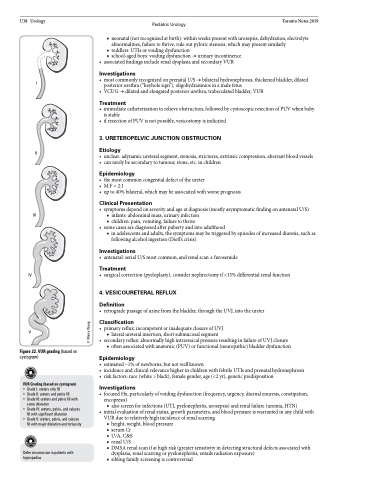Page 1356 - TNFlipTest
P. 1356
U38 Urology
Pediatric Urology Toronto Notes 2019
■ neonatal (not recognized at birth): within weeks present with urosepsis, dehydration, electrolyte abnormalities, failure to thrive; rule out pyloric stenosis, which may present similarly
■ toddlers: UTIs or voiding dysfunction
■ school-aged boys: voiding dysfunction → urinary incontinence • associatedfindingsincluderenaldysplasiaandsecondaryVUR
Investigations
• mostcommonlyrecognizedonprenatalU/S→bilateralhydronephrosis,thickenedbladder,dilated posterior urethra (“keyhole sign”), oligohydramnios in a male fetus
• VCUG→dilatedandelongatedposteriorurethra,trabeculatedbladder,VUR
Treatment
• immediatecatheterizationtorelieveobstruction,followedbycystoscopicresectionofPUVwhenbaby is stable
• ifresectionofPUVisnotpossible,vesicostomyisindicated
3 . URETEROPELVIC JUNCTION OBSTRUCTION
Etiology
• unclear:adynamicureteralsegment,stenosis,strictures,extrinsiccompression,aberrantbloodvessels • canrarelybesecondarytotumour,stone,etc.inchildren
Epidemiology
• themostcommoncongenitaldefectoftheureter
• M:F=2:1
• upto40%bilateral,whichmaybeassociatedwithworseprognosis
Clinical Presentation
• symptomsdependonseverityandageatdiagnosis(mostlyasymptomaticfindingonantenatalU/S) ■ infants: abdominal mass, urinary infection
■ children: pain, vomiting, failure to thrive
• somecasesarediagnosedafterpubertyandintoadulthood
■ in adolescents and adults, the symptoms may be triggered by episodes of increased diuresis, such as
following alcohol ingestion (Dietl’s crisis)
Investigations
• antenatal:serialU/Smostcommon,andrenalscan±furosemide
Treatment
• surgical correction (pyeloplasty), consider nephrectomy if <15% differential renal function
4 . VESICOURETERAL REFLUX Definition
• retrogradepassageofurinefromthebladder,throughtheUVJ,intotheureter
Classification
• primaryreflux:incompetentorinadequateclosureofUVJ ■ lateral ureteral insertion, short submucosal segment
• secondaryreflux:abnormallyhighintravesicalpressureresultinginfailureofUVJclosure ■ often associated with anatomic (PUV) or functional (neuropathic) bladder dysfunction
Epidemiology
• estimated~1%ofnewborns,butnotwellknown
• incidenceandclinicalrelevancehigherinchildrenwithfebrileUTIsandprenatalhydronephrosis • riskfactors:race(white>black),femalegender,age(<2yr),geneticpredisposition
Investigations
• focusedHx,particularlyofvoidingdysfunction(frequency,urgency,diurnalenuresis,constipation, encopresis)
■ also screen for infections (UTI, pyelonephritis, urosepsis) and renal failure (uremia, HTN)
• initialevaluationofrenalstatus,growthparameters,andbloodpressureiswarrantedinanychildwith
VUR due to relatively high incidence of renal scarring ■ height,weight,bloodpressure
■ serumCr
■ U/A, C&S
■ renal U/S
■ DMSA renal scan if at high risk (greater sensitivity in detecting structural defects associated with
dysplasia, renal scarring or pyelonephritis; entails radiation exposure) ■ sibling family screening is controversial
I
II
III
IV
V
Figure 22. VUR grading (based on cystogram)
VUR Grading (based on cystogram)
• Grade I: ureters only fill
• Grade II: ureters and pelvis fill
• Grade III: ureters and pelvis fill with
some dilatation
• Grade IV: ureters, pelvis, and calyces
fill with significant dilatation
• Grade V: ureters, pelvis, and calyces
fillwithmajordilatationandtortuosity
Defer circumcision in patients with hypospadias
© Merry Wang


